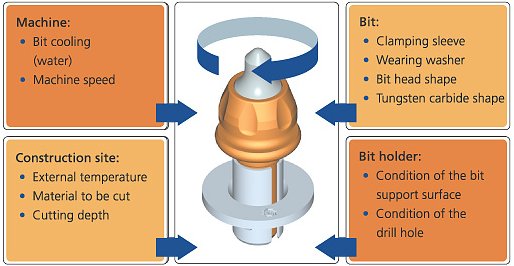
The cutting tools are those parts of the machine with the most immediate contact to the pavement material to be removed. Because asphalt is a highly abrasive material, the cutting tools need to be extremely resistant to wear and tear.
For this reason, the standard cutting tools come with tips manufactured from tungsten carbide, that actually break up the asphalt. Approximately 180 cutting tools are fitted to a standard milling drum with a milling width of 2 m. A fine milling drum of the same width is equipped with approximately 600 cutting tools.

The service life of a cutting tool and, therefore, the profitability of a milling operation depend upon various marginal conditions. The most important factors are shown in the above diagram.
The carbide tip (drawn grey or black respectively) effects the actual cutting work. It is enclosed by a tool head consisting of tempered special steel (drawn red or yellow respectively). The cutting tools differ in the shape and size of the carbide tip and the enclosing tool head. Three examples:
 |
 |
 |
| Mini tool for fine milling | Allround tool | Recycling tool for particularly tough applications |
The shaft of the cutting tool is enclosed by a clamping sleeve allowing the cutting tool to rotate in the toolholder. Good rotating characteristics of the cutting tool are an important criterion for wear and tear, as a uniform wear of the carbide tip and tool head is possible only if the tool can rotate freely in the toolholder, thus ensuring a long service life of the cutting tools.
The cutting tools are not fitted directly to the milling drum but are inserted in toolholders. These toolholders fulfil the function of accommodating the tools, ensuring their rotating performance and enabling their easy replacement. Various systems are available in the market. They differ in the material used and in their user friendliness when replacing the tools.
With modern quick-change toolholder systems the upper part of the holder can easily be replaced on the job site. Sometimes, this may become necessary despite highest demands placed on the materials used and on the manufacturing processes, as toolholders can break due to the extremely high mechanical loads applied during milling.
For reasons of design, fine milling drums are not equipped with quick-change toolholder systems. Instead, the toolholders are welded to the milling drum. The mechanical load is much lower when fine milling, firstly due to the reduced milling depth, and secondly because the mechanical loads applied to each individual tool and toolholder are much lower due to the large number of cutting tools on a fine milling drum.

